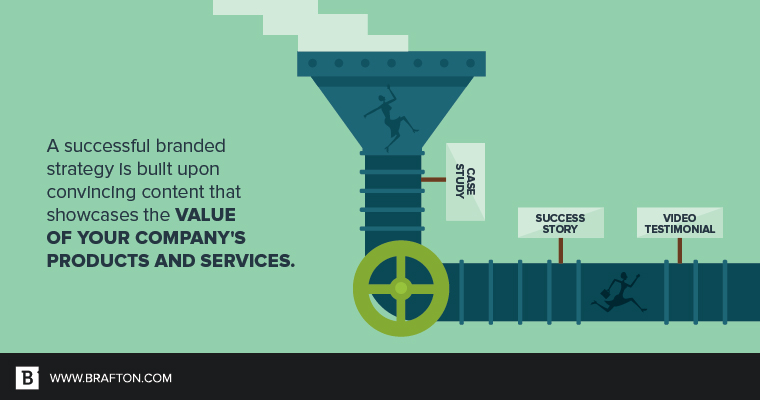Attracting prospects, getting them to your site and introducing them to your brand is no easy feat. Whether it’s through a blog post, social media or a video, your top-of-funnel content is the key player in driving traffic and brand awareness.
But once visitors are in the sales funnel, your work is not done. You’ve got to move them further down and encourage them to continue along the journey with your company.
For B2B organizations, this is much easier said than done. Your sales cycle is often longer than your B2C counterparts, and most of the time, your prospects are not the only decision makers involved in the process.
So now the million dollar question: How do you move those users further down the sales funnel in order to turn them into customers?
The million dollar answer is branded content.
Branded content is any form of content that is clearly associated with your company. While blogs and other top-of-funnel resources are more informative, materials such as case studies, white papers, testimonials and the like are tied closely with your business and how it helped customers achieve a goal or how you are presenting thought leadership.
Read on to find out more about branded content, and how it can be that deciding factor between moving prospects further down the funnel or jumping out of it.
It’s all in your details
For B2B companies, branded content comes in at the mid- and bottom-of-funnel phases. At the top, you’ve provided users with informative content that answers their questions and provides them with a possible solution. Now you’ve got to convince them that your products or services are the right fit for them. You do this with branded content.
“Talking about your industry, sharing knowledge and being interesting can attract your audience, but to make them want to talk to you, you need to start speaking a little more specifically about what you can do for them,” said Brafton Senior Director of Content Marketing Colin Campbell. “That’s where branded content comes in.”
Whether it’s a case study, success story, explanation of your service offerings or a detailed video, you’ve got to make sure you’re giving visitors the right content that convinces them to move further along in the journey with your brand.
Talking about your industry, sharing knowledge and being interesting can attract your audience, but to make them want to talk to you, you need to start speaking a little more specifically about what you can do for them.
This is also where you get the chance to outline what makes your business different from your competition. B2B branded content should outline your differentiator, and give prospects the necessary information to make an engaged decision on becoming your customer. Leaving out these details leaves the door open for users to go elsewhere to find what they are looking for.

From informative to convincing
To hit the right tone with B2B branded content, you’ve got to let your resources do the convincing. Content types such as case studies, success stories and video testimonials are the way to go if you want to encourage prospects to do business with you.
“At the mid- and bottom-of-funnel stages, compelling case studies and customer success stories really do a great job of painting the picture of your value,” said Creative Manager Lauren Fox. “Video testimonials are equally engaging to drive the point home about what you offer to your existing customers. Content geared toward buyers in the decision stage can be even more promotional and informative, whether it’s product guides or product demos. This type of content should speak to how your product or service works.”
Account Director Sonny Sharp also recommended case studies as one of the most effective forms of branded content.
“In a B2B environment, a decision maker can be pushed over the threshold by reading about success stories that his or her potential competitors have seen from a brand’s products or services,” he explained.
Building a robust branded strategy
While B2B branded content is focused mainly on your company and what it does, you can’t forget your audience. Your strategy should be founded on the information visitors are looking for and what they need to know before making a purchase decision.
“Branded content should come from and reflect the context of conversations you’ve actually had or want to have with your most ideal prospects,” Colin said. “You also need to know the ins and outs of how you provide value to those people.”
He explained that many business leaders are not actually able to summarize that value in a few words. But one tactic his account management team has used successfully in the past is to have an ad copy writing session. This forces B2B companies to hone in on what makes their brand stand out from the rest and effectively communicate that vital value.
Branded content should come from and reflect the context of conversations you’ve actually had or want to have with your most ideal prospects.
“The format of an ad forces the team to find something interesting and eye catching that is direct enough and proves how your organization can actually provide crucial value to your prospects,” he said. “Once you’ve got a host of ad headlines, narrow them down to the most important message for you right now. What sorts of leads do you need most immediately, or most importantly? What sorts of messages are worth investing in? Don’t try to invest in all of them at once. Hit one message hard, and do it justice. If it works, keep it. If it doesn’t, move on.”
Another focal point of a great branded content strategy, as Sonny pointed out, is to remember that branding is about a company’s identity and how it wants that identity presented in the marketplace. He stressed that a B2B identity should be woven into the fiber of everything a business does, and into every product or service it delivers.
He offered Salesforce as one example of a successful B2B branded content strategy.
“I really like what Salesforce does from a B2B point of view simply because they really utilize case studies well throughout various channels,” Sonny said. “The company understands its audience, and it understands which channels to reach them on that will be the most effective. There are a lot of customer relationship management tools out there, and Salesforce does a great job of using bottom-of-funnel content to spark interest in prospects.”
Branded content takes time and effort, but it is a key step in moving your prospects from the top of the funnel further along to doing business with you. With the right strategy, you can help guide your visitors and significantly boost your lead generation efforts.





